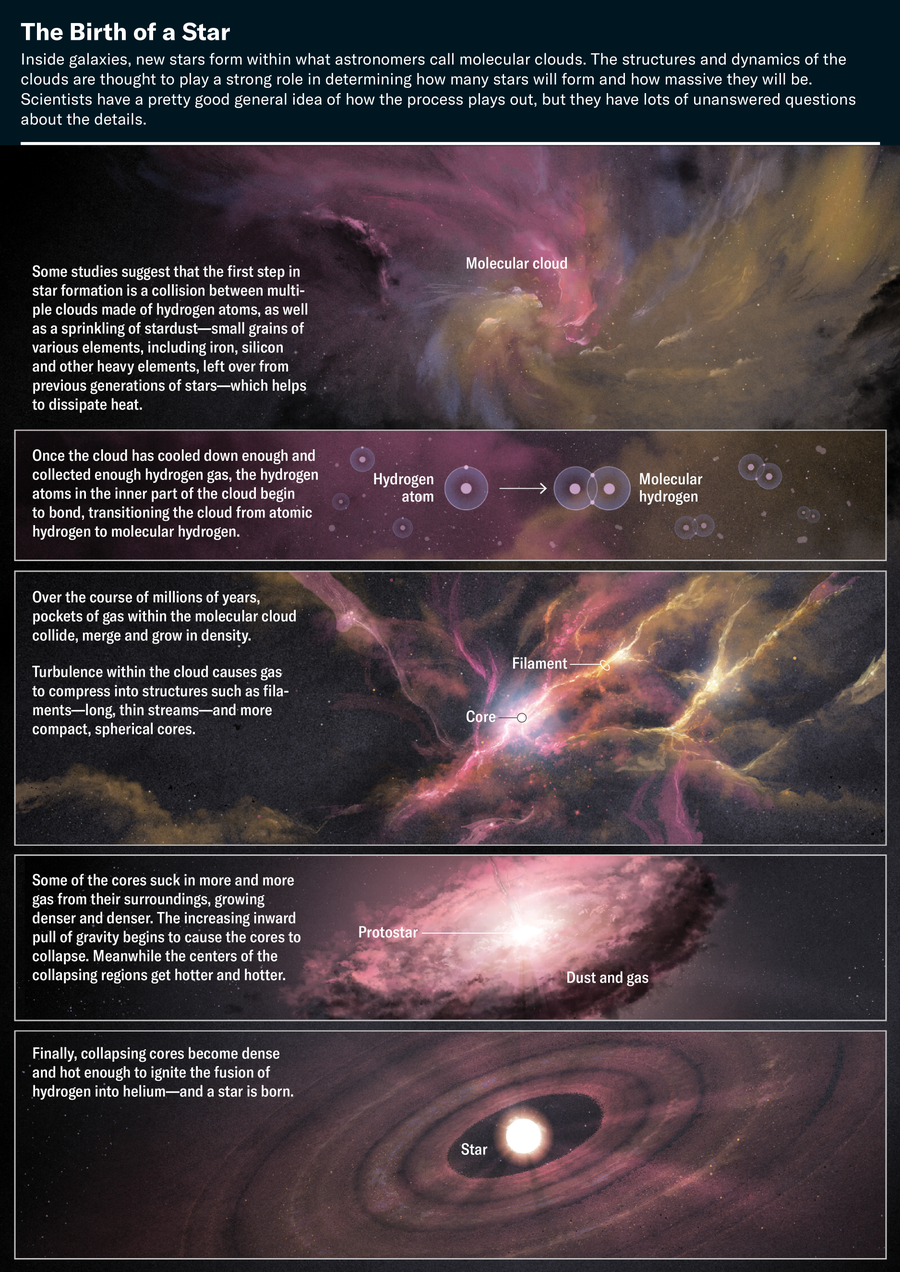Is it a flying elephant? A gingerbread man? When I was little, I used to search the clouds for amusing shapes as they drifted across the sky and imagine stories about their patterns. Now I'm a professional stargazer, and things haven't changed much. These days I search for patterns in molecular clouds, the birthplaces of stars. The shapes I find in these stellar nurseries do more than stimulate my imagination—they also tell a very real story about when, where and how stars are born. For astronomers, understanding this story depends on our ability to identify and interpret the intricate forms we see in the clouds.
Observations reveal elaborate networks of material, including compact clumps of gas and long, skinny, noodlelike structures called filaments woven throughout. Far from being uniform and smooth like milk, molecular clouds are lumpy, more like chicken noodle soup. The gas and dust accumulate into a range of physical scales and are organized into increasingly dense formations. Their structure is hierarchical, like Russian nesting dolls, with smaller shapes enclosed within larger ones. Filaments are much denser than the diffuse gas that fills most of the volume of a cloud. And embedded within filaments are even smaller, denser knots of gas we call cores. These cores represent the final stage before a star is born.
On supporting science journalism
If you're enjoying this article, consider supporting our award-winning journalism by subscribing. By purchasing a subscription you are helping to ensure the future of impactful stories about the discoveries and ideas shaping our world today.
The dynamics of molecular clouds are as complicated as their spatial structure. Stars, planets, and galaxies such as the Milky Way all spin around their axes in a fairly predictable manner. But the space between the stars—the interstellar medium, where molecular clouds reside—is a wild, chaotic frontier. The motions inside clouds are turbulent, with globs and eddies of gas swirling around like capricious fairies. Observations of both the dynamics and the spatial architecture of molecular clouds have enabled astronomers to paint a compelling, if incomplete, picture of how stars are born.
A major reason our understanding is limited is that, although clouds are three-dimensional, our telescope images are flat. We often can't decipher the real shape of a structure within a cloud, because we are seeing it projected onto a flat plane. Intrigued by this problem, I've been inspired to look beyond astronomy for solutions.
In addition to being a scientist, I'm an artist—a painter. This part of me understands that as good as technology can be at recognizing patterns, there are no substitutes for the human eye, brain and imagination. I had the idea to use 3-D printing to create tangible reproductions of molecular clouds that let us peer into the multiple dimensions of these objects. Being able to see and hold mini molecular clouds, I thought, might unlock ways of viewing and thinking about these mysterious regions.
Star birth takes place in the cold and darkness of space. At hundreds of degrees below zero, molecular clouds are among the most frigid regions of the universe. They are composed primarily of hydrogen molecules (two hydrogen atoms bound together) but also contain a significant amount of helium and trace amounts of carbon monoxide and other molecules, as well as a sprinkling of stardust (particles composed of heavy elements created by previous generations of stars). These simple ingredients, together with the freezing temperatures, turn out to be perfect for making stars and planets. Because they are so cold, molecular clouds are virtually invisible in the optical light our eyes can see. Their impressive architecture is best seen in the infrared and radio spectra.
Our observations through infrared and radio telescopes show that long before a star comes into being, a vast cloud of gas dozens of light-years across assembles and evolves under the mutually interacting influences of gravity, turbulence, radiation and magnetic fields. Some studies suggest that a molecular cloud forms when even bigger clouds of atomic hydrogen (single hydrogen atoms) smash into one another. This scenario seems reasonable, given that atomic hydrogen is needed to make molecular hydrogen. Meanwhile dust grains help to dissipate heat from the cloud.
Once enough atomic hydrogen gas has accumulated and cooled down, the inner part of the cloud becomes mostly molecular. At this point, the molecular cloud may have hundreds of thousands to millions of times the mass of the sun. That places stellar nurseries among the largest and most massive entities in galaxies.
The tumultuous motions and magnetic fields inherited by the molecular cloud from its surroundings both play important roles in shaping its structure. Over the course of millions of years, pockets of gas within the cloud collide, merge and grow in density. Internal turbulence causes the gas to become compressed, which quickly leads to the formation of filaments and then cores. Some of the cores continue sucking in mass from their surroundings, like cosmic vacuum cleaners. As the core grows denser, the internal pull of gravity becomes stronger, and the core begins to collapse. Meanwhile the temperature at the center of the collapsing region gets hotter and hotter. The densest cores eventually succumb to the overwhelming force of gravity and initiate nuclear fusion, at which point a star is born!
The Orion Nebula is an active star-forming region that's part of the much larger Orion A molecular cloud. At only 1,400 light-years away, it is the closest stellar nursery where high-mass stars are being built. As you read this, hundreds of new stars are in the process of being born there. Molecular clouds such as Orion A may produce hundreds of thousands, if not millions, of stars over their lifetimes. As it turns out, the star-formation process is very inefficient, and most of a stellar nursery's mass does not wind up in stars, which are tiny in comparison. Imagine it like this: if our sun were the size of a blueberry, its parent molecular cloud might have been the size of Earth or even Jupiter.
This is the big picture of star formation that astronomers have figured out, but there are several key steps in this process that elude us, largely because of the sheer difficulty of observing the literally nebulous structure of stellar nurseries. One of the most conspicuous missing puzzle pieces is how exactly star formation depends on the structures within molecular clouds. For instance, how do filaments and cores determine how big the newborn stars will be? This is a critical question because a star's mass is the single most important factor in its subsequent evolution. Does a filament act as a kind of umbilical cord through which cores and then stars acquire their masses?
During my postdoctoral work, I studied the California molecular cloud, named for its resemblance to the state of California. My collaborators and I explored a small subregion that I dubbed Cal X because of the appearance of two intersecting filaments at that location. While investigating infrared images from the Herschel Space Observatory, we noticed that a number of cores were embedded in each of the two filaments, but none of them showed any indication of becoming stars. Lodged within the junction of Cal X, however, was the most massive core in that region. That core was in the process of delivering at least two baby stars.

Imara, who is a painter as well as a scientist, uses art to inspire and inform her research. Credit: Stephanie Mei-Ling
When I analyzed what was going on in Cal X, I discovered what appeared to be flows of gas along the filaments, as though they were funneling material to the gargantuan core. As suggestive as the evidence was, however, I couldn't entirely rule out other possibilities. Perhaps gas was flowing away from the filaments, or maybe they were rotating, or possibly some combination of all these things was happening.
My hunch is that the filaments of Cal X are indeed serving as cosmic umbilical cords to the stars being formed in the region. Studies of other molecular clouds, as well as computer simulations, have shown similar patterns in filaments and provide compelling evidence for this scenario. But one of the main reasons that it is so challenging to draw a definitive conclusion is that our observations typically can't show the 3-D geometry of stellar nurseries. To say conclusively what is happening in the California molecular cloud, we would need to know how the filaments are positioned with respect to one another and to the rest of the cloud. But in a flat image, it is impossible to tell whether they are tilted toward or away from us or perhaps slant in opposite directions. It's like trying to tell which way a river is flowing when all you have is a bird's-eye view of the landscape—and no way to distinguish between mountains and valleys.
A connected question about the relation of molecular cloud structure to star formation is, What sets the rate at which stars are born? The Milky Way produces stars at a leisurely pace of about three solar masses' worth of stars every year. But so-called starburst galaxies that flourished in the early universe have outlandishly high star-formation rates that are tens or even thousands of times that of our galaxy. Could it be that stellar nurseries in starbursts have a fundamentally different architecture than those in normal galaxies?
In the past decade these questions have come to the fore as images of the interstellar medium taken with Herschel, as well as with the Atacama Large Millimeter Array (ALMA) in Chile and other telescopes, have highlighted how significant cloud substructure might be in star formation. Within molecular clouds throughout the Milky Way and other galaxies, we see complex networks of filaments at a range of size scales from a few to hundreds of light-years long. And within filaments, the densest cores seem to be the preferred birth sites for stars. In spite of the challenges of interpreting our observations, it's clear that understanding the origin and evolution of dense gas in molecular clouds may be the key to making progress toward a fuller theory of how stars come to be.
When studying molecular clouds, I'm often reminded of lyrics from a song in my favorite movie, The Sound of Music: “How do you catch a cloud and pin it down?” Since my graduate school days, I've been preoccupied with the idea of trying to “catch” stellar nurseries. I've looked into various algorithms created to identify molecular clouds and quantify their substructure. But it can be tough to interpret the results of algorithms that are designed to identify 3-D structures from 2-D images. How do we draw a meaningful boundary around a star-forming core swimming in an ocean of dust and gas? Unrelated material in front of or behind the core could be tainting our view. Or, if we're trying to quantify the properties of overlapping filaments, how can we tell where one ends and another begins in the tangle? Could it be that our perspective sometimes leads us to confuse certain structures for something else?
I had the idea to use 3-D printing to visualize structure in stellar nurseries. I wanted to be able to hold the stars in my hand. Unlike some other methods of visualization, 3-D printing represents astrophysical structures in a way that taps into the human brain's ability to recognize patterns. Moreover, interactive 3-D structures can engage our intuition in ways that 2-D representations can't. I began collaborating with John Forbes of the University of Canterbury in New Zealand and James C. Weaver of Harvard University's John A. Paulson School of Engineering and Applied Sciences. We became the first research group to use 3-D printing to visualize star formation.

Credit: Matthew Twombly
To start, we ran several simulations representing various physical extremes. One simulation had very strong gravity; another had weaker magnetic fields than we usually observe in real clouds. The point was to isolate various aspects of physics to see how they drive the evolution of molecular clouds in different ways. We used the simulations, rather than observations of real clouds, as source data for the 3-D print designs because simulations can be run in three dimensions. When we simulate stellar nurseries, it is as if we are omniscient demigods because at any moment we know everything that's happening at each location in the simulation. Our knowledge is limited, of course, by the parameters we put into the simulation, but these inputs are well informed by observations. We tested the resulting models to make sure they met our standards for resembling real molecular clouds. Then we postprocessed the simulation data, putting them in a format that could be understood by our 3-D printer, which prints in very thin sheets of resin. It layered more than 2,500 sheets on top of one another to build a sphere.
When I finally held one of my stellar nurseries for the first time, I was captivated. I turned the softball-size globe around in my hand, examining its twisting structures from all angles. I could see filaments snaking through the cloud and dissolving into the background. I could see cores, wispy puffs, planar structures and forms I had no names for. My colleagues and I also printed half-spheres so we could better see what was going on deep inside the clouds, and I was surprised by how dramatically the structure started to change just below the surface. In observations of real stellar nurseries, much of this material is projected onto the plane of the image, so there's no way to tell what's in front and what's behind. Now, holding a stellar nursery with my fingertips, I could see what was going on with a simple twist of the wrist. It was beautiful.
One big surprise was that the shapes of structures within molecular clouds are even more complex than we thought. As my team and I suspected, sometimes what appeared to be a filament from one angle was a flat, sheetlike structure in projection. In other words, a filament might be a pancake viewed along its edge. But we also noticed filaments embedded in pancakes, which raises the tantalizing possibility that filaments emerge from sheets.
I think of our 3-D prints as interactive maps. They show us where to look to identify the structures that play key roles in star formation. More important, they help us cultivate our ability to see things from a new perspective so we can look at observations of real clouds with fresh eyes and potentially discover patterns we hadn't noticed before.
Years before I thought about using 3-D printing as a visualization tool for stellar nurseries, I drew a sketch of myself holding a star in my hand. And years before that, as a graduate student writing my dissertation, I imagined myself flying through molecular clouds, compressing millions of years of their evolution into a few minutes. I'm not sure I would have come up with the idea of using computers to create sculptures of stellar nurseries had I not been an artist.
Stellar nurseries are among the most complex (and, in my opinion, the most beautiful) objects in the cosmos. In recent years excitement about deducing their 3-D structure has increased in our field as advances in the quality and variety of observations have made it possible to explore their architecture in new ways.
Using data from the Gaia space observatory, for instance, researchers have created 3-D maps of the dust associated with molecular clouds near the sun. One study compared two of my favorite clouds, Orion A and California. These two stellar nurseries are an interesting case study because they lie at roughly the same distance from us; they have comparable masses, each containing about 100,000 times the mass of the sun in molecular hydrogen; and in 2-D images, they have similar oblong shapes. California is slightly more massive, but curiously, it produces stars at a rate nearly 100 times slower than Orion A's. Why?
According to the study, it turns out that whereas Orion A is a relatively compact cloud shaped like a big cigar, California is a more flattened, extended structure—like the “pancakes” in my 3-D printouts. But because of its orientation in space, we see it from the side, and in flat images, it appears more compact than it really is. Astronomers have known for decades that star formation tends to happen faster in denser gas. The difference in the 3-D shapes of California and Orion A might explain their disparate star-formation rates. The shapes of clouds and, ultimately, star formation are influenced by how gas flows within them. Going forward, my colleagues and I are incorporating colors into our 3-D prints to explore the motions of structures within stellar nurseries.
A new generation of telescopes, including the James Webb Space Telescope, ALMA, and other observatories, is collecting data across the electromagnetic spectrum and improving our quantity, quality and variety of star-formation observations. With advances in numerical simulations keeping pace, both theorists and observers are sprinting to develop ways to solve the mysteries of star birth. The artist in me is convinced, however, that our most important tool remains our imagination. Just like when we were children lying on the grass and watching the clouds pass overhead, our imagination can see things that the rest of our mind can't and may lead the way to the discoveries we hope for.
Editor’s Note (4/5/24): This article was edited after posting to correct the descriptions of the composition of molecular clouds and the fusion of hydrogen into helium in stellar birth.

